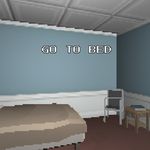

Go To Bed takes a seemingly simple idea—getting a child to sleep—and turns it into a chaotic survival game packed with distractions, resource management, and increasingly bizarre interruptions. It tests patience, strategy, and your ability to maintain calm under pressure.
Each round of Go To Bed starts with a basic objective: help the child fall asleep by managing the surrounding environment. Sounds easy, until the distractions pile on. You must shut windows, turn off lights, block out noise, and deal with random events trying to disturb sleep.
Players must juggle multiple tasks while watching stress meters. Letting the child get too agitated resets your progress. You earn calming points by making smart decisions, which can be used to buy upgrades like automatic shutters or better sleep routines.
As Go To Bed progresses, the gameplay escalates. Paranormal entities, surreal dream sequences, and even intrusions from broken dream logic disrupt your strategies. These later levels demand more precise reaction and multi-layered planning.
Go To Bed isn’t just about sleep; it’s a mind-bending management game that throws you into a nightly routine of madness. With clever use of timing, strategy, and pattern recognition, you can bring peace to the chaos—at least until the next night begins.